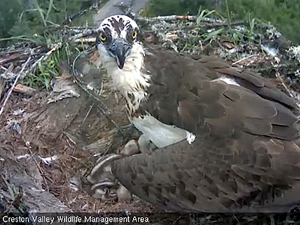
A web cam jointly operated by the Fish and Wildlife Compensation Program (FWCP) and the Creston Valley Wildlife Management Area (CVWMA) is providing animal lovers with a close-up look at day-to-day life in an osprey nest.
The camera was installed in early April, prior to the ospreys’ return to the wetland area near Creston. The design allows the camera to be swung down on an arm to enable easier cleaning. Being so close to the nest means the camera lens can come under direct fire, mostly from flying remnants of fish.
The first chick hatched on June 16, the second two days later and the third on June 22. As a result, the third chick was much smaller than the other two and found it difficult to compete for food. It also did not look like the mother paid extra attention in making sure the weakest hatchling received the food and hydration it required and it died on June 27.
The two remaining chicks were doing well and looking healthy but between the evening of July 5 and the morning of July 6 the oldest of the two chicks went missing. A thorough ground search directly below the nest was carried out, but nothing was found. It may have been bothered by insects, become disoriented and fallen out, or been taken by a predator (owl or eagle) directly from the nest. Officials with the FWCP are hoping that the third and final chick will fledge successfully.
The osprey nest cam shows live-streaming images of the hatching, feeding and daily life of a pair of osprey and their chicks; the shrieking of the young as the adult male came into close range to deliver fish; the female feeding her young; and how she would mantle her wings to protect them from the elements.
The camera was installed in early April of 2011, prior to the ospreys’ return. The design allows the camera to be swung down on an arm to enable easier cleaning. Being so close to the nest means the camera lens can come under direct fire, mostly from flying remnants of fish!
The juveniles will remain in their nest all summer, so there is lots of time to watch them develop.
You can access the osprey cam from its button at the bottom of The Current’s front page or by clicking here.



